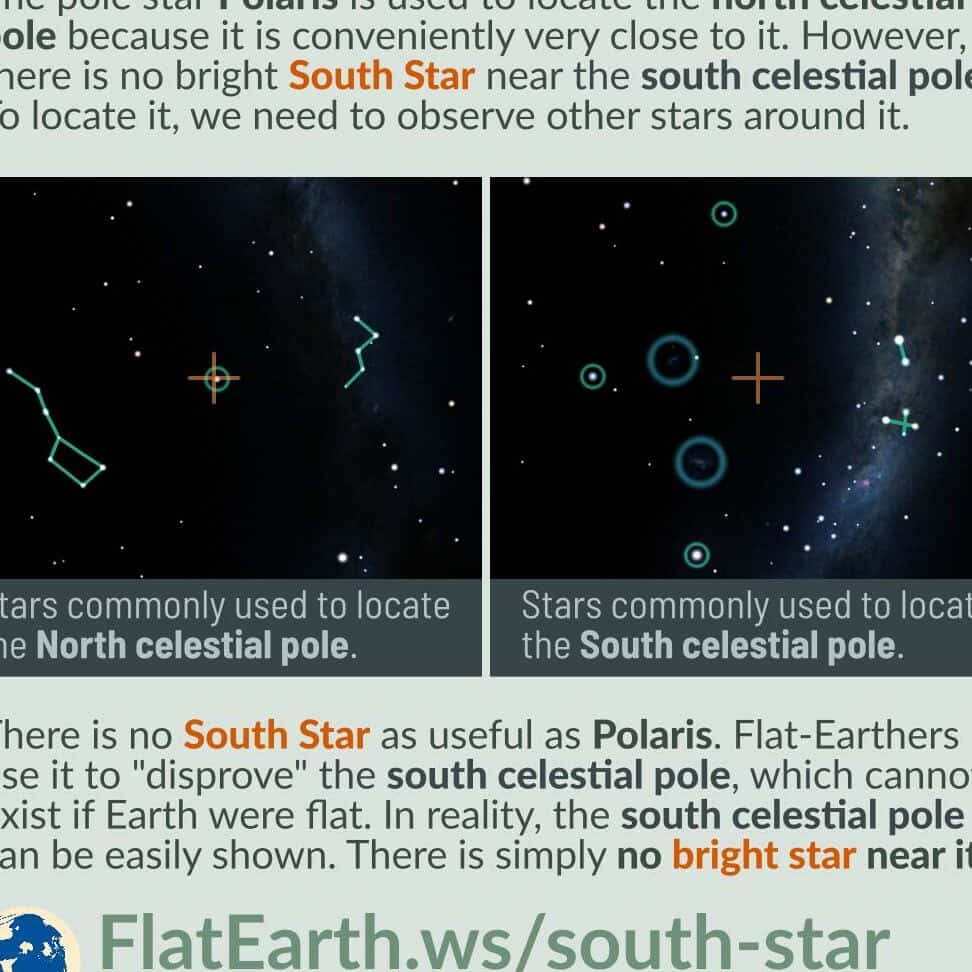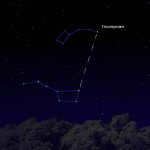

The enigmatic, radiant, distant yet near Polaris has captivated scientists for centuries. Even with modern technology, astronomers have yet to unravel the mysteries surrounding this star. It steadfastly serves as a navigational guide to the North, assisting lost travelers in finding their way, while simultaneously keeping its own secrets from the realm of science.
In ancient mythology, Polaris is intertwined with various tales. According to one legend, the Little Bear is the son of Zeus Arkad, while another story claims that Zeus transformed the nymphs Melissa and Kinosura into the Big and Little Bears as a token of gratitude for saving their lives.
Discovering the North Star: A Guide
Finding the North Star, also known as the Polaris, can be a challenging task. The Small Bucket asterism, while not particularly bright, holds the key to locating this celestial gem in the night sky. By using the stars of the Big Bucket asterism within the Big Dipper constellation, you can navigate your way to the North Star.
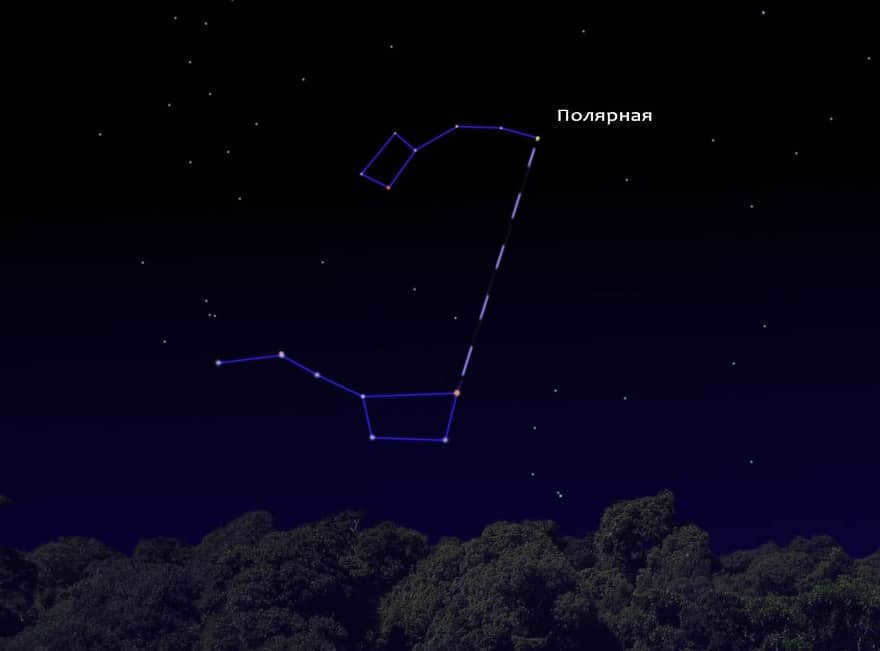

In order to locate the North Star, you can draw a line from Merak to Dubhe and then extend it by 5 similar sections. The stars within the frame include Dubhe, Merak, Fedha, Megretz, Aliot, Mitsar, Alkaid, and Polaris.
Also, you can read about how to find the North Star in the starry sky and learn more about the methods and subtleties of finding it.
To locate Polaris in the sky, you can use the stars Dubhe and Merak in the Big Dipper asterism. These stars are located in the outer part of the asterism. By drawing an imaginary line, you will reach the North Star (counting 5 segments). The Big Dipper asterism revolves around Polaris, completing one revolution in 23 hours and 56 minutes.
Polaris is located at the tip of the tail of the Little Bucket asterism, serving as its handle. Despite its faint brightness, it can still be visible to the naked eye under favorable conditions, without the need for magnifying equipment.
Locating Polaris is a simple task due to its alignment with Earth’s axis of rotation, which causes it to hang over the North Pole. It appears virtually motionless, while all other stars appear to revolve around it. This position remains constant throughout the year. The process of observing Polaris varies depending on your location. For example, if you are in New York City, you should look 41 degrees above the northern horizon (which correlates with the local latitude). In equatorial regions, the star will be right on the horizon. As you move further north, Polaris will be lower below the horizon line.
Polaris, which is located in the constellation of Ursa Minor, has served as a useful tool for navigation since ancient times. Currently, it is positioned 0.7 degrees away from the North Pole. However, this has not always been the case. Around 2500 BC, the celestial pole was situated in the constellation Draco. Then, in 400 B.C., Beta of Ursa Minor took on the role of the navigational star. Looking ahead to the year 14000, the star Vega in the constellation Lyra will replace Alpha as the North Star.
March 24, 2100, marks the anticipated closest approach of Polaris to the pole, with a projected distance of 27.15 angular minutes between them. Interestingly, there is no prominent star in the southern hemisphere that can be used as a celestial guide. Furthermore, no such star is expected to emerge in the next 2,000 years.
Christian legend
Throughout their journey, the Magi were guided by a enigmatic celestial body that led them to the exact location where Jesus Christ, the son of God, was born. These three wise astronomers learned of this momentous event through the alignment of stars and were compelled to embark on a pilgrimage to witness the newborn and present him with their precious gifts. Thus, the Christian legend of the nativity and the manifestation of the guiding star as a symbol of this occurrence came to be. This narrative represents just one interpretation of the story.
The Polaris star system
It is important to remember that we are dealing with an entire star system with unique characteristics and classification. The primary star, Alpha of the Little Bear Aa, is a yellow supergiant (F7). It is 2500 times brighter than the Sun, 4.5 times more massive, and has a radius 46 times larger than the Sun. This star belongs to the variable Cepheid class, exhibiting pulsations over a span of four days.
Polaris A is a well-known variable I Cepheid star, making it the brightest star in the sky. These stars are instrumental in helping scientists calculate distances between galaxies and clusters. The brightness of Polaris A varies by 0.03 magnitudes over a period of 3.97 days. The variability in brightness was initially discussed in 1852 but was only confirmed in 1911.
The star Alpha Minor Aa is accompanied by two other stars. The closest companion is Ab, which is a dwarf star (F7) located at a distance of 17 astronomical units (a.u.) and has an orbital period of 29.6 years. Another companion, Alpha Minor B, is a dwarf star (F3) located at a distance of 18 arc seconds and has an orbital period of 42,000 years. This star was first observed by astronomer William Herschel in 1780.
In addition to these two companions, Alpha Minor Aa also has two other companions named C and D. The north celestial pole can be found between Polaris and the star Lambda of the Little Bear constellation.
In 1929, the binarity of Polaris A was confirmed. The Hubble Space Telescope was able to observe all three stellar components in 2006. Since it was first observed by Greek astronomers, the brightness of the star has increased by a factor of 2.5.
The Significance of Self-Esteem
When an individual has a guiding light that serves as a point of reference in their life, such as a goal, a plan, or a dream they are working towards, they are the type of person who does not dwell on trivial matters. In contrast to those individuals we encounter along our life journey who hold onto petty grievances or hurtful words spoken in the heat of an argument, they lack a guiding light, a goal, a dream, or the ambition to move forward without getting stuck in past accomplishments or looking back.
Sometimes, a person becomes so mesmerized by a distant and brilliant goal, like a guiding star, that they lose touch with reality and disregard everything else in life, considering it unnecessary and “inferior”. In reality, the presence of this guiding star is closely tied to a person’s self-worth. It is unfortunate when it is absent, and even worse when it is unattainable. The key is to find the “golden mean” – the right and true benchmark. Discovering and defining it can be a challenging task, but often it is the most crucial aspect of life.
Physical characteristics and orbit
- Polaris: Alpha of Ursa Minor.
- Constellation: Ursa Minor.
- Distance: 325-425 light years.
- Coordinates:
- Alpha of Ursa Minor A – 2 h 31 m 49.09 s (right ascension), +89° 15'50.8″ (declination).
- Alpha Minor B – 2 h 30 m 41.63 s (right ascension), +89° 15'38.1″ (declination).
- Apparent magnitude: 1.98 (Aa), 9.2 (Ab), 8.7 (B).
- Absolute magnitude: -3.6 (Aa), 3.6 (Ab), 3.1 (B).
- Spectral class: F7Ib (Aa), F6V (Ab), F3V (B).
- Variable type: classical Cepheid.
- Mass: 4.5 times that of the Sun (Aa), 1.26 times that of the Sun (Ab), 1.39 times that of the Sun (B).
- Radius: 46 times that of the Sun (Aa), 1.04 times that of the Sun (Ab), 1.38 times that of the Sun (B).
- Luminosity: 2500 times that of the Sun (Aa), 3 times that of the Sun (Ab), 3.9 times that of the Sun (B).
- Temperature: 6015 K (Aa), 6900 K (B).
- Names: Polaris, North Star, Alpha of the Little Bear, Arcadia, Navigation, HR 424, HD 8890, SAO 308, FK5 907, GC 2243, ADS 1477, CCDM 02319+8915, HIP 11767.
| List of stars |
| Sun – Sirius (α Big Dog) – Canopus (α Kiel) – Arcturus (α Volopassus) – Vega (α Lyra) – Capella (α Ascendant) – Rigel (β Orion) – Procyon (α Little Dog) – Betelgeuse (α Orion) – Altair (α Eagle) – Aldebaran (α Taurus) – Antares (α Scorpio) – Spica (α Virgo) – Pollux (β Gemini) – Fomalgaut (α South Pisces) – Deneb (α Swan) – Regulus (α Leo) – Adara (ε the Big Dog) – Castor (α Gemini). |
General descriptive parameters
Polaris is larger in size compared to the Sun. It consists of a primary star and two smaller companions, as well as two more distant objects. One of these distant objects was first discovered by W. Herschel in 1780. The primary star is a member of the Ursa Minor constellation. It is well-known among astronomy enthusiasts due to its visibility and the fascinating legends associated with it.
One of the most debated topics in scientific circles is the distance of Polaris from our solar system. Despite extensive research, little is currently known about this distance. Recent estimates suggest it is around 434 sv years or 133 parsecs. However, some scientists speculate that it may actually be closer to us, possibly by around 30%.
Regardless of the circumstances, Polaris can be found within 1 degree (or even less) of the north pole, making it almost stationary in the daily movement of the sky. This makes it particularly useful for orienting oneself on the ground, as the direction to Polaris is nearly identical to the direction north. Additionally, the height above the horizon of Polaris is equal to the latitude of the observation location.
However, due to the phenomenon of precession, the position of the North Pole is not fixed and can vary over time. In the period from March 7th to June 13th, 2012, Polaris was closest to the North Pole. Since then, it has been gradually moving away. Scientists predict that by the middle of the year 2260, the distance between Polaris and the North Pole will exceed 1 degree. It is worth noting that there is no bright Polaris in the southern hemisphere.
Key Characteristics of Polaris
To find the bright pointer using a compass, you will need to have knowledge of the altitude and coordinates. The direction can be easily determined by observing the arrow with a mark. It is important to hold the compass horizontally and wait for the arrow to settle. The north arrow will indicate the correct direction.
The altitude of the desired point can be determined by considering the latitude of the terrain. This information can be found from reliable sources. Alternatively, you can use a specialized compass that displays the slope of the terrain. By following this straightforward method, you will be able to identify the constellation in which Polaris is located and locate it using simple tools.
Stars in the sky of the north
Similar to how the Earth is divided into the eastern and western halves, the night sky can also be divided into two halves – the northern and southern hemispheres. There is also an equatorial region. We are located in the northern part, so let’s focus on that.
The stars in the northern hemisphere are the stars that can be observed by people living north of the equator. These stars are not visible to individuals residing in the southern hemisphere because, on a universal scale, the Earth maintains a fixed position in relation to the other stars.
There are certain constellations in the northern hemisphere that are always visible. These constellations are located near the polar star and serve as a guide to the North Pole. Some of these constellations include the Big and Little Bears, Andromeda, Cassiopeia, the Dragon, Cepheus, Lynx, and the Hounds.
On the other hand, there are constellations that appear at different times of the year or go below the horizon. During the summer months, constellations such as Perseus, the Northern Crown, Lyra, Veronica’s Hair, the Magpie, and Hercules can be easily seen. In winter, one can observe Orion, especially because the bright Betelgeuse is one of the first stars to appear in the sky. However, it’s important to take into account the latitude of one’s location, as the northern half of the Earth is quite large. What is visible to someone living in the north may differ from what is visible to someone living in the south.
This is the end of the theoretical section. Now, we move on to the practical aspect of our exploration of the night sky.
Function as the closest and brightest celestial body
Without any doubt, Polaris indicates the direction of north. It is situated in the vicinity of a straight line formed by the Earth’s axis of rotation. Polaris remains almost stationary, and most celestial objects in the Northern Hemisphere appear to revolve around it. Occasionally, Polaris may shift its position from a visual perspective, but this occurs infrequently. Therefore, it is considered normal for the Earth’s axis and Polaris to align on the same line.
The movement of the celestial body across the heavens plays a significant role. In the coming years, this occurrence is closely linked to the Earth’s axis procession. Scientists have made preliminary predictions that after the 21st century, the Earth’s axis will shift, causing a change in the North Star. The new North Star is expected to be Gamma Cepheus, tentatively in the 41st century. Currently, the distance from the North Pole is approximately 1.4 times the diameter of the moon.

The North Star or Stella Polaris is a star that is ideally bright and is practically aligned with the axis of a rotating astronomical object.
Currently, the North Star of the Earth is Polaris (Alpha Ursae Minoris), a star with a magnitude of -2, which is roughly aligned with the Earth’s northern axis. It is a prominent star used in astronomical navigation. On the Earth’s southern axis is Polaris Australis (Sigma Octantis), a much dimmer star.
Between approximately 1700 B.C. and just after A.D. 300, Kochab (Beta Ursae Minoris) and Pherkad (Gamma Ursae Minoris) were the twin stars near the North Pole. However, neither of them was as close to the pole as Polaris is today.
Historical Background
During ancient times, the position of Kochab in relation to the celestial north pole was closer than Alpha Minor. Although there wasn’t a visible star near the pole, the midpoint between Alpha and Beta of the Little Bear was in close proximity to the pole, giving the impression that the entire Little Bear constellation, referred to as Kochab in antiquity, was near the pole. The Phoenicians utilized the term Kynosura (Greek: Κυνόσουρα, meaning “dog’s tail”) as a navigational aid for determining north. The Little Dipper, also known as Cynosure in anglicized form, has since become synonymous with a “guiding principle” due to its use in navigation.
The first star of the Little Bear (Polaris) has been described as ἀειφανής (transliterated as aiphanes), which means “constantly visible”, “perpetually shining”. This description was given by Stobaeus in the 5th century, when the star was still approximately 8 degrees away from the celestial pole. In 10th-century Anglo-Saxon England, it was known as scip-steorra (“star-ship”), reflecting its use in navigation. In the Vishnu Purana, the star is personified as Dhruva (“motionless, immovable”).
The term stella polaris was coined during the Renaissance period, despite the fact that it was widely acknowledged at that time that it was a few degrees away from the actual celestial pole. In 1547, Gemma Frisius defined this difference as 3 degrees and 8 minutes. The explicit connection between Mary and stella maris or the Polar Star is evident in the work titled Cynosura seu Mariana Stella Polaris (which translates to “Cynosure, or Mariana Polaris”), a compilation of Marian poems published by Nicolae Lucensis (Niccolò Barsotti) de Lucca) in 1655.
Precession of the equinoxes
In October 2012, Polaris was positioned at a declination of + 89° 19′8″ (in the J2000 epoch it was + 89° 15′51.2″). As a result, it continually appears in the northern part of the sky with an accuracy of less than one degree, and the angle it forms with the true horizon (after adjusting for refraction and other factors) is equivalent to the observer’s latitude rounded to the nearest degree. By the year 2100, the celestial pole will be closest to Polaris before gradually moving further away.
During the first millennium BC, the star known as Beta Minor Bear, or “Cohab,” was the brightest star closest to the celestial pole. However, it was not close enough to serve as a reliable marker for the pole. The Greek navigator Pytheas, around 320 BC, described the celestial pole as lacking any stars. In the Roman era, the celestial pole was roughly equidistant between Polaris and Cochabus.
The precession of the equinoxes is a cycle that takes approximately 25,770 years to complete. By February 2102, the average position of Polaris, accounting for both precession and proper motion, will reach its maximum declination of +89° 32′ 23″, which is 1657″ (or 0.4603°) away from the north celestial pole. On March 24, 2100, the declination, accounting for nutation and aberration, will be +89° 32′ 50.62″, which is 1629″ (or 0.4526°) from the north celestial pole.
The upcoming procession will cause the north celestial pole to aim towards the stars of the northern constellation Cepheus. By 3000 AD, the pole will shift into space, equidistant between Polaris and Gamma Cepheus (“Errai”), while Errai will align closest with the north celestial pole around 4200 AD. Around 5200 AD, Iota Cepheus and Beta Cepheus will flank the north celestial pole before approaching the brighter star Alpha Cepheus (“Alderamin”) around 7500 AD.
Precession will cause the north celestial pole to point towards stars in the northern constellation of Swan. In the 1st millennium B.C., Beta Ursae Minoris, the brightest star closest to the celestial pole, was 7 degrees away and was not close enough to be considered a pole marker. However, in the 10th millennium A.D., Deneb, a first magnitude star, will be in closer proximity to the pole but still not close enough to serve as a pole marker. On the other hand, Delta Swan, a third magnitude star, will be 3 degrees away from the celestial north and will be a more useful polar star around A.D. 11500. As precession continues, the celestial north pole will move closer to the constellation Lyra, where Vega, the second brightest star in the northern celestial hemisphere, will become the polar star around 13,700 A.D., although it will still be 5 degrees away from the celestial north.
Over time, the motion of precession will gradually shift the celestial north pole towards the stars in the constellation Hercules, specifically pointing towards Tau Hercules around the year 18,400 AD. Eventually, the celestial pole will shift back towards the stars in the constellation of the Dragon (specifically Tuban, as mentioned earlier) before returning to its current position in the Little Dipper constellation. Interestingly, when Polaris once again becomes the North Star around the year 27,800 AD, it will actually be further away from the pole than it currently is due to its own motion. In contrast, back in 23,600 BC, Polaris was actually closer to the pole.
Throughout the 26,000-year period of Earth’s axial precession, a sequence of brilliant stars visible to the naked eye (with an apparent magnitude of up to +6; the full moon is -12.9) in the northern hemisphere will be referred to as Polaris. While other stars may align with the north celestial pole during this 26,000-year cycle, they may not meet the brightness threshold required to be a reliable indicator of north for an observer on the ground. As a result, there are periods in the cycle when Polaris is not clearly defined. Additionally, there will be times when bright stars only provide a rough indication of “north” as they may deviate by more than a 5° angular diameter from direct alignment with the Earth’s north pole.
Star of the Southern Hemisphere (Polar Star)
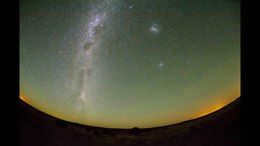
Play Media
Here is a visual representation of the Earth’s axis rotating in relation to the south pole. The video showcases the Magellanic Clouds and the Southern Cross, which are clearly visible. Towards the end of the footage, the rising moon adds illumination to the scene.
One of the most useful stars in the southern hemisphere is currently Polaris. While Sigma Octantis is the closest naked eye star to the south pole, it is barely visible with an apparent magnitude of 5.47 on a clear night, making it unsuitable for navigation. Polaris is a yellow giant located 294 light-years away from Earth. As of 2000, it is approximately 1° away from the pole. Within the Southern Cross constellation, Polaris serves as the approximate south pole, indicating the location of the south pole star.
Both Polaris and the Southern Cross can be seen from the equator. The south celestial pole has been moving towards the Southern Cross, which has been pointing towards the south pole for the past 2000 years. As a result, the constellation is no longer visible from subtropical northern latitudes, as it was during the time of the ancient Greeks.
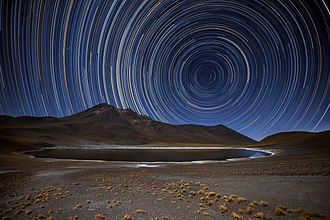
In the next 7500 years, the southern pole will come close to the stars Gamma Chamaeleontis (4200 AD), I Kili, Omega Kili (5800 AD), Epsilon Kili, Turais (Aspidiske, 8100 AD), and Delta Sails (Alsephina, 9200 AD). From the 80s to the 90s centuries, the southern celestial pole will pass through the False Cross. Around AD 14000, Canopus will have a declination of -82°, which means it will rise and set daily at latitudes between 8° south and 8° north latitude, and it will not rise for observers north of this last 8th parallel north.
Due to precession and proper motion, Sirius will become a future south pole star: at a declination of 88.4°S in 66,270 AD, and at a declination of 87.7°S in 93,830 AD.
Alternative planets
Other celestial bodies have their own unique pole stars: these are stars that can be seen with the naked eye (if conditions are perfect) and are brighter than 6th magnitude. They are positioned closest to the projection of the planet’s axis of rotation onto the celestial sphere. Each planet has its own set of pole stars, as their axes are oriented differently. (Refer to Poles of astronomical bodies.)
- Mercury’s south pole star is Alpha the Painter, while its north star is Omicron Draconis.
- The closest star to the north pole of Venus is 42 Draconis. Etagus Doradus is the closest to the south pole. (Note: The International Astronomical Union follows the right-hand rule to determine the positive pole for orientation purposes. According to this convention, Venus is tilted at 177°, or “upside down.”)
- The south pole star of the Moon is Delta Doradus, while the north pole star is Omicron Dragon.
- Kappa Velorum is located only a few degrees away from the south celestial pole of Mars. The two top stars of the Northern Cross, Sadr and Deneb, indicate the north celestial pole of Mars.
- Jupiter’s north pole is situated just over two degrees from Zeta Dragon, and its south pole is approximately two degrees north of Delta Dorada.
- Delta Octantis serves as the south pole star of Saturn. Its north pole is located in the far northern region of Cepheus, about six degrees away from Polaris.
- This Serpent acts as the north pole star of Uranus, while 15 Orion serves as the south pole star.
- Neptune’s north pole points halfway between Gamma and Delta Swan. Its south pole star is Gamma Velorum.
In religion and mythology
In religious and mythological beliefs, Polaris held significant meaning. It was commonly referred to as the “stella maris” or “star of the sea” due to its crucial role in navigation at sea. This association can be found in various texts, such as Bartholomeus Anglicus’ work (d. 1272) which was translated by John Trevisa (1397):
“This star is known by astronomers due to its position in relation to other stars and celestial bodies. It stands out from the rest due to its unique location. Its vastness is hidden by its position, and it serves as a guide for sailors, hence its name “stella maris” – the lord of the throne, as it leads men who navigate and possess seafaring skills.”
Polaris has been connected to the veneration of the Virgin Mary for a long time. The Virgin Mary is often referred to as the Star of the Sea. This belief can be traced back to the different interpretations of St. Jerome’s translation of Eusebius’ Onomasticon and De nominibus hebraicis, which were written around 390. In his translation, Jerome suggested that the name Mary in Hebrew could be derived from the phrase “stilla maris,” which means “drop of the sea.” However, this interpretation later became misinterpreted as “stella maris,” meaning “star of the sea.” This misreading can also be found in the manuscript tradition of Isidore’s Etymologia from the 7th century, and it is believed to have originated during the Carolingian era. Interestingly, a manuscript of Jerome’s text from the late 9th century still uses the term “stella” instead of “stilla.” However, in the 9th century, Paschasius Radbert explicitly referred to the metaphor of the “Star of the Sea,” stating that Mary is like a guiding star who helps us navigate through the stormy waves of life and find our way to Christ.
In Mandaean belief system, Polaris holds a significant role and is associated with the celestial realm known as the World of Light or “heaven”. When the Mandaeans pray, they face towards the North, and their temples are also oriented in this direction. On the other hand, the South is connected with the World of Darkness.
In the context of Japan, Polaris was symbolized by Myken Bosatsu (妙 見 菩薩).
In Greek magical papyri, Polaris was linked to Set-Tiphon.
According to Chinese mythology, Emperor Zhuangxu is identified as the deity of Polaris.
In Hindu mythology, specifically in Indian tradition, Polaris is known as Dhruva. Dhruva was a devoted follower of Vishnu and was transformed by Vishnu into an eternal star.
Polar constellations can be seen near the World Poles, both the north and south poles.
The issue is that there is no polar circle in the sky. The problem lies in the fact that there is no polar circle in the sky that resembles the geographic circle, thus making it difficult to determine the exact “close proximity” of constellations to the pole.
One solution could be to simply include the traditional polar constellations in the list: the two Bears, the Dragon, Cassiopeia, and others. However, there is no such tradition for the southern hemisphere, making it unclear which constellations should be included in the list of southern circumpolar constellations.
Therefore, I needed to create a pair of imaginary polar circles, positioned at the optimal angle from the poles (specifically 23°26'). Any constellations that are situated either partially or entirely within these circles will be classified as polar (circumpolar, subpolar, or if you prefer, circumterrestrial).
Constellations in the Polar Region
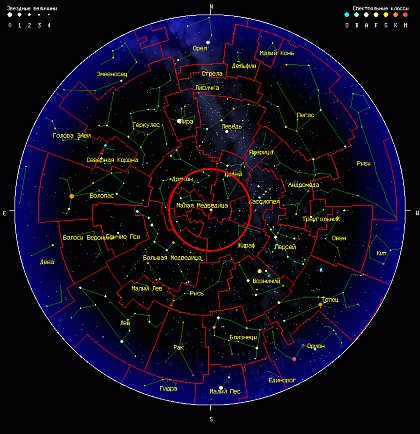
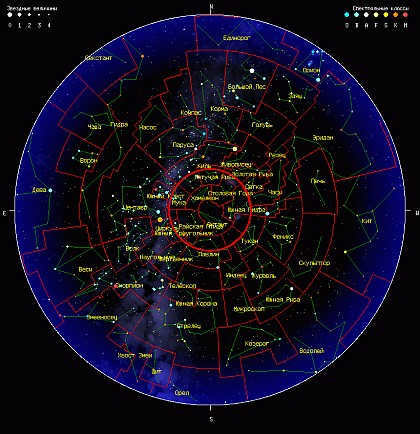


There are 6 traditional constellations in the list of northern circumpolar constellations. However, the southern constellations are much more abundant, consisting of 17 constellations, most of which were created by Lacaille and Plancius.
Southern Hemisphere
The South Pole is situated in Octanthus and is not marked by any special star, but it is represented by the Southern Cross (which is oddly not a circumpolar constellation).
Zodiacal constellations are located along the annual path of the sun, while the Equatorial constellations are positioned along the celestial equator. When it comes to the polar constellations, there is no clear and distinctive description, except for the fact that “they are directly overhead in the north”. However, these constellations can be characterized through rather complex observations.
One cannot see the constellations of the North Pole when they are below the southern tropic, known as the Tropic of Capricorn. Similarly, the constellations of the South Pole cannot be seen when they are above the northern tropic, known as the Tropic of Cancer.
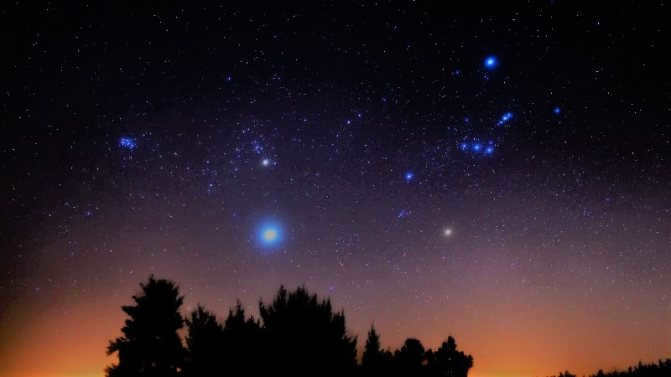

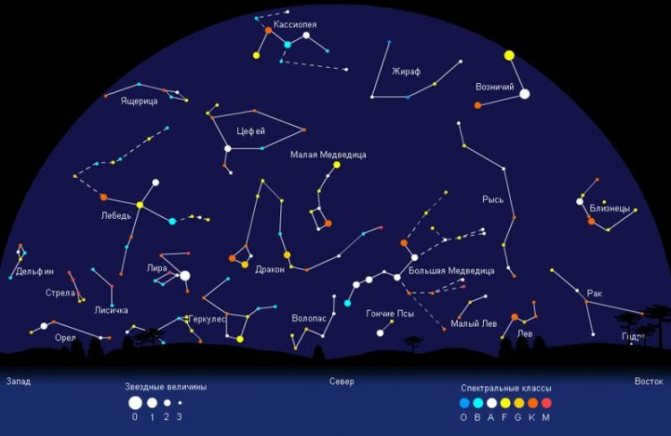
The celestial bodies that are utilized for navigation purposes are the Sun, Moon, Venus, Mars, Jupiter, and Saturn along with 26 other stars that are bright and easily recognizable.
When it comes to identifying navigational stars, the most prominent features taken into consideration include the configuration of constellations, the relative positions of stars, and their apparent brightness.
Instructions for locating navigational stars in the northern hemisphere[1] Instructions for locating navigational stars in the southern hemisphere[2]
As per the decision made by the International Astronomical Union, the entire celestial sphere is divided into 88 constellation regions, with over 60 of them visible from the former USSR territory.
The navigational stars consist of the following (with the bold ones being for the Northern Hemisphere)[3]:
- Alpheratz
(Alpha Andromeda) - Polaris
(alpha of the M. Bear) - Aliot
(epsilon of the B. Bear) - Regulus
(alpha of Leo) - Deneb
(alpha of Swan) - Fomalgaut
(alpha of South Pisces) - Antares
(Scorpio alpha) - Pollux
(beta Gemini) - Spica
(alpha Virgo) - Betelgeuse
(Orion’s alpha) - Aldebaran
(alpha of Taurus) - Altair
(alpha of Eagle) - Rigel
(beta Orion) - Arcturus
(alpha Volopas) - Capella
(alpha of Ascendant) - Vega
(alpha Lyra) - Sirius
(alpha B. Dog) - Canopus (alpha Argo)
- Ahernar.
- alpha Centauri
- Beta Southern Cross
- alpha of the Southern Triangle
- epsilon of Sagittarius
- Peacock (alpha Peacock)
- Hamal (alpha Aries).
The precise coordinates of celestial landmarks are determined from the Aerial Astronomical Yearbooks (AAE).
Additionally, similar information can be accessed online, for example, on the Naval Oceanography Portal website [5] in the section Celestial Navigation Data for Assumed Position and Time.
The designations of the stars in the figures below are provided in English.
For the Northern Hemisphere, please refer to Figure 6. For the Southern Hemisphere, please refer to Figure 6.
References
- Kondratyev N.Y. “Astronomy in Aviation” 1950
- Flight Simulator 2004: A Century of Flight Real Stars mod Realistic display of stars in FS2004
- MyFsStars 1.0 – Stars and constellations for Flight Simulator 2004 (FS2004, FS9) Realistic display of stars in FS2004
- Stars and constellations for Flight Simulator 2004 Surrealistic (with constellation drawings) display of stars in FS2004.
- Methodical instructions for laboratory works on navigational astronomy Panasenko A.N.
- History of names of navigational stars
The most popular stars for navigation
These stars are documented in nautical almanacs and enable the determination of coordinates for any point on Earth.
A nautical almanac is a compilation, a publication that consolidates scientific works and data on a specific subject.
Of course, the coordinates of navigational stars and knowledge of constellation locations are essential in their identification. As a result, lists, tables, atlases, and sky maps have been created for convenience.

The Nautical Almanac
Chart of the primary celestial bodies for navigation
| 1 | Alpheratz | 21 | Pollux | 41 | Alfecca |
| 2 | Ancaa | 22 | Avior | 42 | Antares |
| 3 | Shedar | 23 | Suhail | 43 | Atria |
| 4 | Difda | 24 | Miaplacidus | 44 | Sabik |
| 5 | Ahernar | 25 | Alfard | 45 | Shaula |
| 6 | Hamal | 26 | Regul | 46 | Ras Alhage |
| 7 | Akamar | 27 | Dubhe | 47 | Etamin |
| 8 | Menkar | 28 | Denebola | 48 | Kaus Australis |
| 9 | Mirfak | 29 | Hyenach | 49 | Vega |
| 10 | Aldebaran | 30 | Akruks | 50 | Nunki |
| 11 | Rigel | 31 | Hakruks | 51 | Altair |
| 12 | Capella | 32 | Aliot | 52 | Peacocke |
| 13 | Bellatrix | 33 | Spica | 53 | Deneb |
| 14 | El-Nat | 34 | Alkaid | 54 | Enif |
| 15 | Alnilam | 35 | Hadar | 55 | Alnair |
| 16 | Betelgeuse | 36 | Menkent | 56 | Fomalgaut |
| 17 | Canopus | 37 | Arcturus | 57 | Marcabus |
| 18 | Sirius | 38 | Rigel Centaurus | 58 | Polaris |
| 19 | Adara | 39 | Zuben Elgenuby | ||
| 20 | Procyon | 40 | Cohab |
As you may observe, the table showcases certain luminaries that are emphasized in bold font. To be honest, the common characteristic among these luminaries is their usage in navigation within Russia. Essentially, these 18 celestial bodies serve as prominent and convenient points of reference for orientation in the Russian territory.
Furthermore, it is worth noting that all the objects listed possess either a first or second star magnitude. Presumably, this attribute contributes to their practicality.
Primitive Observatory
This technique requires some preliminary preparation. You will need to bury two sticks of varying lengths in the ground. By observing the movement of any star, except for Polaris, in relation to these sticks, you can easily determine the direction you are facing.
If the star moves upwards, you are facing east. If it moves downwards, you are facing west. If the star moves in a clockwise loop, you are facing north, and if it moves in a counterclockwise loop, you are facing south.
Also, check out: Occlusal Bandages and Plasters: What They Are, Indications for Use, and Application Technique
It is important to note that this method only provides approximate directions and should only be relied upon in the most dire circumstances.
Description of fascinating constellations in the Northern Hemisphere
Andromeda
Andromeda is a constellation in the northern hemisphere that consists of three brilliant stars arranged in a linear formation. One of these stars is Alamac, which is a triple system comprised of a main star with a yellow hue and a magnitude of 2m, as well as two companion stars that have a bluish color. Alferatz, also known as Alpharet, has an Arabic name meaning “Sirrah ap-Faras,” which translates to “the navel of the horse.” Both Alferatz and Alamac are used as navigational stars for sailors to orient themselves at sea. The third star in this constellation is Mirach, which is situated between the other two stars.
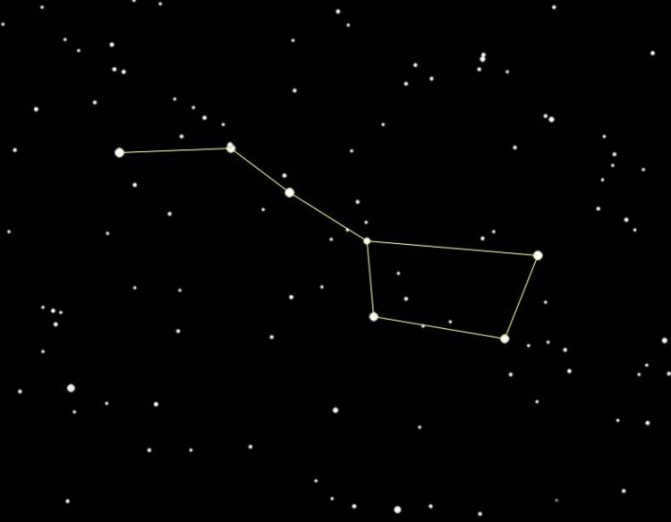
Ascendant
Ascendant is a constellation located in the near-polar region of the sky in the northern hemisphere. The brightest star in Ascendant is Capella, which is a yellow double star. Capella’s name in Latin means “goat” or “goat star”. It is the sixth brightest star in the sky and has a luminosity that is 170 times greater than the Sun’s. Capella is a giant star located 13 parsecs away. Interestingly, Capella is actually a system of six stars, but unfortunately, they cannot be seen separately even with good binoculars.
Volopassus
Volopassus is a stunning constellation located in the northern hemisphere of the sky. It captivates observers with its unique arrangement, which resembles a parachute filled with air. In this depiction, the parachutist represents Arcturus, the third brightest star in the night sky. The name of this star originates from the words “arktos,” meaning guardian, and “ursus,” meaning bear. Thus, the constellation is often referred to as the “guardian bear,” as it follows the path of the Big Dipper across the celestial sphere.
Veronica’s hair
Veronica’s hair is absolutely stunning.


The constellation known as Veronica’s Hair can be found in the sky of the northern hemisphere and consists of approximately 60 stars that can be seen without the aid of a telescope. The most prominent star in this constellation, Veronica’s Hair, has a brightness of 4.3 magnitudes. By observing this star, one can get a glimpse of what our Sun would look like from a distance of 27 light years, as it shares many similarities with our own star.
Hercules is one of the biggest constellations in the northern hemisphere. During a clear and moonless evening, you can spot approximately 140 stars with the naked eye in the Hercules constellation. The brightest stars among them are part of the third magnitude. By mentally connecting these stars with lines, you will form a distinct geometric shape of two large trapezoids sharing a common base, stacked on top of each other.
Dogs of the Hunt
The Dogs of the Hunt are a compact constellation located in the northern hemisphere of the celestial sphere, consisting of approximately thirty stars that can be easily observed with the naked eye. The most luminous star of this constellation was given the name by the renowned English astronomer Edmund Halley, in tribute to King Charles II, who played a significant role in the restoration of the monarchy in England during the 17th century. This particular star is visually splendid, as it is a binary system: one component shines with a radiant golden-yellow hue (magnitude 3.2), while the other emanates a vibrant purple glow (magnitude 5.7), positioned at a separation of 20 arcseconds from the primary star. For optimal viewing, it is recommended to employ binoculars or a small telescope.
Dragon
The mythical creature known as the dragon is a popular figure in various cultures around the world. It is often depicted as a large, winged reptile with fiery breath and the ability to fly. In many stories and legends, dragons are portrayed as powerful and fearsome creatures, capable of causing destruction and chaos. However, they are also sometimes depicted as wise and benevolent creatures, capable of offering guidance and protection. The image of the dragon has been used in art, literature, and popular culture for centuries, making it a truly iconic and timeless symbol.
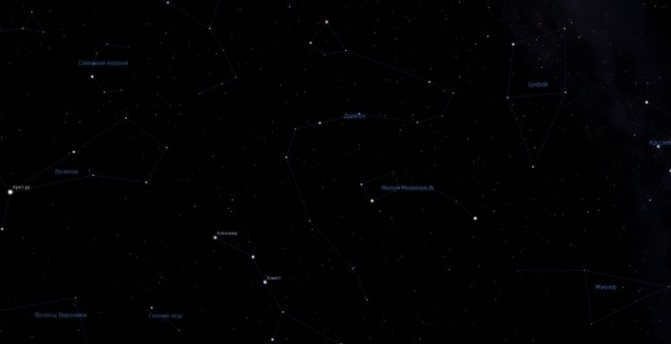
The Dragon constellation is located near the North Pole in the sky and is known for its vast size. It is home to over two hundred stars that are visible to the naked eye, with 80 of them being brighter than 6t. One of the notable stars in the constellation is Tuban, also called “Snake” (alpha Dragon, 3.7), which served as the northern polar star between 3700 and 1500 B.C. The brightest star in the constellation is Etamin (gamma Dragon, 2.2). In Arabic, al-Ras al-Tinnin translates to “the head of the Dragon”. Another intriguing star in the Dragon constellation is Kuma (nu of the Dragon), which is an optical double and can be clearly seen through binoculars.
Cassiopeia is a constellation located in the northern hemisphere of the sky that does not set. It is home to approximately 90 stars that are visible to the naked eye and have a brightness of 6 or higher. Among these stars, the brightest ones are Rukbach, Rukba, Navi, Shedar, and Kaf. These stars form a distinct pattern resembling the letter “W,” which is used by navigators to determine their position at sea. Navi, in particular, is an extraordinary variable star that exhibits a flaring new star-like behavior, causing its brightness to fluctuate between 1.6 and 3. Another variable star in Cassiopeia is Cassiopeia’s variable ro Cassiopeia, which changes its brightness from 4 to 6.2. Once its brightness reaches 6.2, it becomes invisible to the naked eye. This particular star is classified as a supergiant and is 40 times more massive and about 500,000 times brighter than the Sun.
Constellation of Swan
The Swan constellation is located in the northern hemisphere of the sky. Its bright stars create a distinct cross-shaped pattern known as the “Northern Cross” that stretches across the Milky Way. Throughout history, different cultures have associated this constellation with various birds. The Babylonians referred to it as a “forest bird,” while the Arabs saw it as a “chicken.” One of the most prominent stars in Swan is Deneb, which is often referred to as the “chicken tail.” Deneb is a blue supergiant star that shines with a luminosity 67,000 times greater than that of the Sun. It is positioned in the upper left corner of the “Summer Triangle.” Another notable star in Swan is Albireo, which represents the beta “chicken’s beak.” Albireo is a stunning double star system that can be easily observed using a small telescope.
The Little Dipper
The constellation known as the Little Bear can be found in the northern hemisphere, close to the polar region. It is comprised of around forty stars that are visible to the naked eye. Currently, the North Pole is situated within the Little Bear, less than 1° away from the star known as Polaris. Within the Little Bear, there is a group of seven stars that is commonly referred to as the “Little Bucket”. The outermost star in the “handle” of the Bucket is Polaris, which is the alpha star of the Little Bear and has a brightness of 2.0. The next brightest star is Kohab, also known as the beta star of the Little Bear, with a brilliance of 2.1. Between the years 2000 B.C. and 500 A.D., Kohab served as the polar star. The name Kohab zl-Shemali, which is translated from Arabic, means “Star of the North”.
The Lesser Horse Constellation
The Lesser Horse is a small constellation located in the northern hemisphere of the sky. It is known for being the smallest constellation in terms of area. On a clear night, only up to ten stars can be seen with the naked eye. These stars, although faint, do not form any distinct geometric shape that would catch the attention of observers. The brightest star in the Lesser Horse constellation is known as Kitalpha or al Kitah al Faras in Arabic, which translates to “part of the horse”. It has a luminosity of 3.9 star magnitude. The remaining stars in the constellation have a brightness that does not exceed 4.5 and do not have any proper names.
Orion
Orion is a constellation located on the celestial equator and visible throughout the world. It is one of the most recognizable constellations in the night sky, known for its distinctive pattern of three bright stars that form Orion’s Belt. The constellation is named after Orion, a hunter in Greek mythology. According to the myth, Orion was a giant and skilled hunter who was eventually killed by a scorpion sent by the jealous goddess Artemis. In the night sky, Orion is surrounded by other prominent constellations such as Taurus and Gemini. It is also home to several notable deep-sky objects, including the Orion Nebula, a massive cloud of gas and dust where new stars are born. The Orion constellation has been a subject of fascination and study for astronomers throughout history and continues to captivate stargazers today.
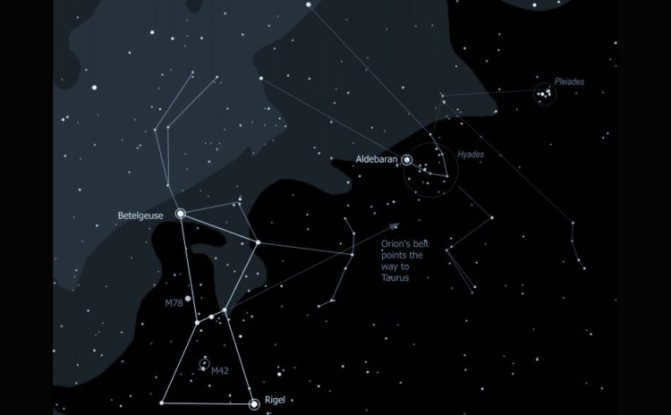
Orion is a well-known constellation in the northern hemisphere with a unique arrangement of stars. The star Betelgeuse, also known as alpha Orion, has an interesting name derived from Arabic meaning “armpit”. It is classified as a red supergiant and is known for its irregular variability, with its brightness ranging from 0.2 to 1.2. Located at a distance of 520 light years, Betelgeuse shines with a luminosity that is 14,000 times greater than that of the Sun. This star is truly enormous, being one of the largest known to astronomers. In fact, if it were to replace the Sun, it would extend all the way to the orbit of Jupiter. Betelgeuse has a volume that is 160 million times larger than that of the Sun.
Pegasus is a constellation situated in the southwestern region of Andromeda. It encompasses more than 150 stars that can be observed with the naked eye. The most prominent stars in Pegasus are Enif, which has a magnitude of 2.5, and Markab (alpha Pegasus), which has a magnitude of 2.6. Another notable star in the constellation is Sheat (beta Pegasus), which has a variable magnitude ranging from 2.4 to 2.8. The Arabic names of the brightest stars in Pegasus have significant meanings: Markab represents a “saddle” or “wagon”, Sheat symbolizes a “shoulder”, Algenib signifies a “horse’s navel”, and Enif represents a “nose”.
Perseus
Perseus is a group of stars in the sky of the northern hemisphere that forms a distinctive shape resembling an open loop. The most prominent star in the constellation of Perseus is called Mirfak, which derives its name from the Arabic word meaning “elbow”. This massive celestial body, situated approximately 590 light years away, has a star magnitude of 1.8 and is 62 times larger than the Sun, emitting light that is 5000 times brighter.
Arrow
Arrow is an exquisite and compact constellation located in the northern hemisphere. It boasts a collection of approximately thirty stars that can be observed without the aid of a telescope. While lacking in prominent stars, one star in particular stands out in Arrow – Sham, which is also known as the Arrow star. Another notable feature of this constellation is the presence of the variable FG of Arrows, a type of variable star that has been named after it. Over the course of a century, the temperature of FG Arrow has fluctuated dramatically, ranging from 50,000 to 4,600 degrees Kelvin, and its atmospheric composition has also undergone changes. Notably, the FG Arrow star emits vast quantities of carbon dust, leading to the expansion of its envelope.
Triangle
Triangle is a stunning yet compact constellation situated in the northern hemisphere. It comprises of approximately twenty stars that have a magnitude of 6 or greater. When observed without the aid of a telescope, this constellation appears in the form of a right-angled triangle positioned below Andromeda. The highest point of this triangle is represented by the star Metallakh (alpha), which is translated from Arabic as “apex of the triangle”. The most luminous star within this constellation is beta, possessing a brilliance of 3.
Cepheus
Cepheus is a celestial formation located in the northern region of the sky, showcasing a unique and irregular pentagonal shape. The lower section of Cepheus intersects with the Milky Way, adding to its allure. This constellation boasts an impressive collection of approximately one hundred and fifty stars, all of which can be easily observed without the aid of a telescope. While Cepheus lacks any particularly luminous stars, the brightest member of this celestial group is Alderamin (alpha Cepheus), which shines with a magnitude of 2.4. Additionally, Delta Cepheus, a binary star system, is among the notable members of this constellation. This double star possesses a luminosity that ranges from 3.7 to 4.5 and has a period of 5.4 days. The discovery of Delta Cepheus is credited to the English amateur astronomer John Goodricke, who made this remarkable finding in 1784.
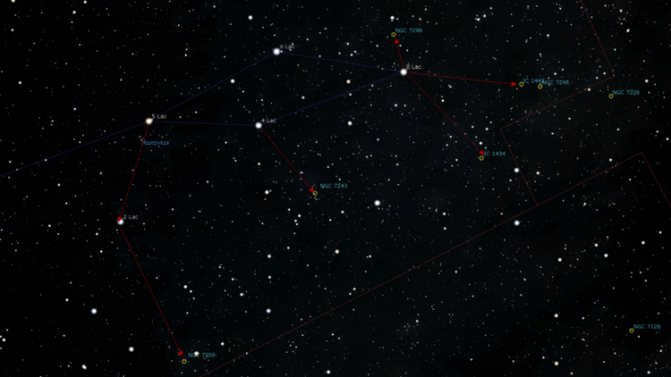
The constellation known as the Lizard is a small formation situated along the Milky Way. Its dim stars do not create any distinct recognizable shape. When the sky is clear, it is possible to spot approximately thirty stars without the aid of a telescope. Among these stars, only one shines particularly bright with a magnitude of 3.8. Therefore, the entire constellation is visible only during nights when the moon is not present and the observing conditions are optimal.
Constellation Positions
Having a good understanding of constellations makes it easy to determine the directions of the world on a clear night. The positions of the constellations change not only throughout the night, but also over the course of the year. It is important to note that at midnight, you can observe different constellations depending on the month: in January, it’s the Big Dog and Little Dog; in March, Leo; in May, Volopassus; in November, Taurus; and in December, Orion. Additionally, the Milky Way stretches approximately from south to north, but these directions are only rough estimates, so it is advisable to use the Milky Way as a reference point for additional reassurance only.
Guiding Yourself Using Celestial Bodies
It’s important to consider that the weather plays a significant role in celestial observation. When the sky is cloudy, it obscures the view of stars and other celestial objects. This factor should be taken into consideration. However, there are situations where observing the stars becomes crucial, rather than just a planned activity.
Regardless, whether you’re an observer or a pilot navigating a ship in space, sea, or any other environment, there are generally two main objectives:


Stars above the ocean
Firstly, the altitude of the celestial body above the horizon is determined using a sextant (a specialized measuring device). This yields a line of position. Subsequently, multiple lines are intersected on a map to determine the observer’s location.
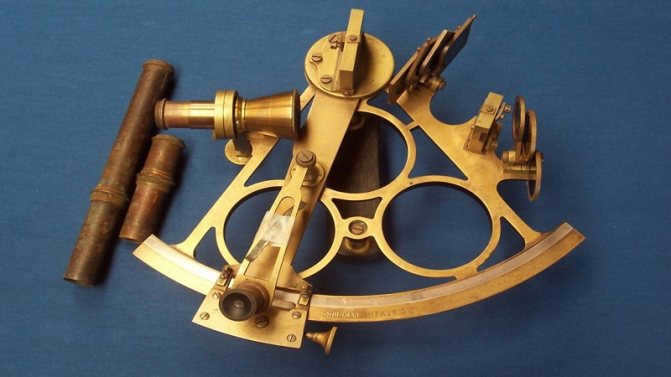
Sextant (instrument)
Alternatively, you can utilize the celestial bodies as guides to determine compass correction values. To accomplish this, compare the stellar body’s azimuth with the azimuth calculated using the ship or vessel’s compass.
However, the choice of landmark object is based on either their name or Bayer designation. The stars’ positions are indicated by the equatorial coordinate system, specifically their declination and right ascension (the stellar complement is denoted in navigation).
In addition to the celestial bodies, navigation by the stars, Moon, and planets is also possible. For instance, the position of Mars, Venus, Saturn, and Jupiter can determine location and direction.
Southern Hemisphere
In order to avoid getting disoriented and accurately navigate in the Southern Hemisphere, it is crucial to use the Southern Cross as a reference point, which points directly to the south. This constellation consists of five bright and easily distinguishable celestial bodies.
Located at the lower left side is the Coal Sack, an area where nothing can be seen. Not far from it, you can spot two bright stars belonging to the Centaurus constellation.
To determine the direction towards the South, you need to draw an imaginary straight line between the two farthest stars. On this line, locate a specific point. To do this, connect all the stars of the Centaurus constellation and visualize a perpendicular line. The intersection of these two lines indicates the position of the South Pole.
Take note! Occasionally, the Southern Cross may be mistaken for the False Cross. The primary method for identifying the correct constellation is to locate Centauri on the left. Another characteristic that sets them apart is the larger gap between the stars in the False Cross.

